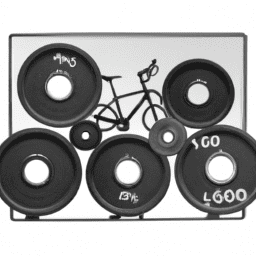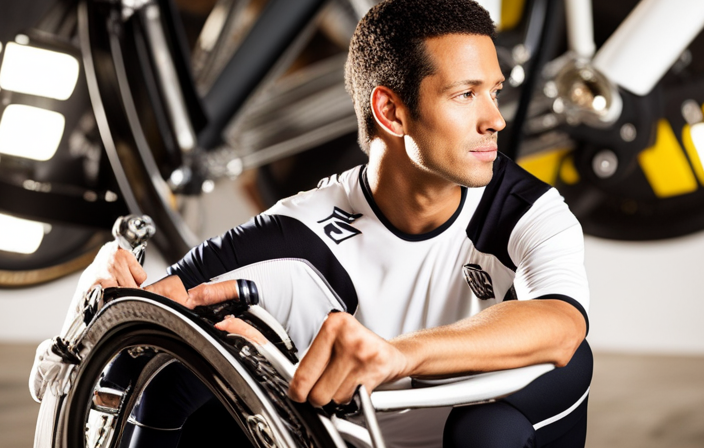Cycling offers a unique sensation incomparable to anything else. It feels as though you’re soaring without wings, cruising along roads with the wind caressing your hair and the sunlight warming your skin.
But have you ever wondered how much your bike weighs? It’s not just a trivial fact; knowing your bike’s weight can affect your ride in more ways than you might think.
A bike’s weight can affect its maneuverability, speed, and overall performance. A lighter bike can be easier to handle, accelerate faster, and climb hills with less effort.
On the other hand, a heavier bike can provide more stability and control, especially on rough terrain. So, whether you’re a casual rider or a competitive cyclist, knowing your bike’s weight is crucial to maximizing your performance and enjoyment on the road.
Key Takeaways
- Bike weight affects ride in various ways, with lighter bikes being easier to handle, accelerate faster, and climb hills with less effort.
- The type of bike, frame material, and components such as wheels, brakes, and gears all play a role in determining bike weight.
- Common bike frame materials include aluminum, steel, carbon fiber, and titanium, with carbon fiber frames absorbing road vibrations for a smoother ride.
- Regular maintenance, including cleaning, lubrication, and proper storage, is essential to keep components in good working order and extend bike longevity.
The Importance of Knowing Your Bike’s Weight
You need to know your bike’s weight, as it could be the difference between an easy ride or a grueling workout.
When it comes to cycling, weight is one of the most important factors that can affect your performance on the road. The lighter your bike, the easier it is to ride, and the faster you can go. Conversely, a heavier bike will require more effort to ride and can significantly impact your endurance.
The importance of weight for cycling performance cannot be overstated. The weight of your bike will determine how much energy you need to expend to keep it moving. This, in turn, affects your endurance, as the more energy you use to ride your bike, the shorter your ride will be.
Therefore, it’s essential to know the weight of your bike to help you plan your rides and ensure that you’re not pushing yourself too hard.
Now let’s take a look at the factors that affect a bike’s weight.
Factors Affecting a Bike’s Weight
When it comes to determining a bike’s weight, there are several key factors to consider. As someone who’s been cycling for years, I know that the type of bike you’re riding can have a significant impact on its overall weight.
Additionally, the components and materials used in the bike’s construction can also contribute to its weight.
Types of Bikes
If you’re in the market for a lightweight bike, you may want to consider a road bike or a carbon fiber frame. Road bikes are designed for speed and efficiency, with thin tires and lightweight frames. They come in different sizes to fit riders of varying heights and are made with materials such as aluminum, carbon fiber, or steel.
Carbon fiber frames are another option for those looking for a lighter bike. They are made of a composite material that is both strong and lightweight. Carbon fiber frames can absorb road vibrations to provide a smoother ride, and they are often used in high-end road bikes. However, they can be more expensive than other types of frames and may not be as durable as steel or aluminum.
When it comes to bike weight, the type of bike and frame material are two important factors to consider. But weight is not the only aspect to consider when choosing a bike. The components, such as the wheels, brakes, and gears, also play a role in determining a bike’s overall weight and performance.
Components
One of the key factors in determining a bike’s overall performance and ride experience is the quality and type of components used in its construction. Bicycle components are the parts that make up the bike, including the brakes, gears, pedals, and chain. Each component plays a critical role in the bike’s function and must work together seamlessly for optimal performance.
Regular maintenance is essential to keep all components in good working order. Some common problems include worn brake pads, loose pedals, and gears that don’t shift smoothly. Keeping the bike clean and lubricated can also help prevent issues from arising. By keeping an eye on these components and addressing any problems promptly, you can ensure a smooth and enjoyable ride.
As we move on to the next section about materials, it’s important to note that choosing high-quality components is just as essential as selecting durable materials.
Materials
To truly enhance your riding experience, you’ll want to consider the materials used in constructing your bike. The type of material used affects the weight, durability, and overall performance of your bicycle. The most common materials used in bicycle construction are aluminum, steel, carbon fiber, and titanium. Each material has its own advantages and disadvantages, which can impact your decision when choosing a bike.
The table below provides a breakdown of the advantages and disadvantages of each material:
| Material | Advantages | Disadvantages |
|---|---|---|
| Aluminum | Lightweight, affordable | Can be stiff and less comfortable |
| Steel | Strong, durable, comfortable | Heavy and can rust |
| Carbon Fiber | Lightweight, strong, absorbs vibrations | Expensive and can be brittle |
| Titanium | Lightweight, strong, durable, comfortable | Expensive |
Understanding the materials used in bicycle construction is crucial in determining the right bike for your needs. Next, we’ll explore the average weights of different types of bicycles to further help you in your decision making.
Average Weights of Different Types of Bicycles
As a cyclist, I’m always interested in knowing the average weights of different types of bicycles.
Road bikes, which are designed for speed and efficiency on paved surfaces, typically weigh between 7 and 10 kilograms.
Mountain bikes, which are built for off-road terrain, tend to be heavier, with an average weight ranging from 11 to 15 kilograms.
Hybrid bikes, which combine features of both road and mountain bikes, fall somewhere in between, weighing around 8 to 12 kilograms.
Finally, BMX bikes, which are designed for freestyle and stunt riding, are generally the heaviest of the bunch, weighing in at around 12 to 16 kilograms.
Road Bikes
Road bikes typically weigh around 7 to 10 kilograms, making them a lightweight and speedy option for cycling enthusiasts. The design of road bikes focuses on aerodynamics and weight reduction, which contributes to their lightweight nature. Here are four factors that affect the weight of road bikes:
-
Frame material: The most common materials used for road bike frames are aluminum, carbon fiber, and titanium. Carbon fiber is the lightest and most expensive, while aluminum is the most affordable but also the heaviest.
-
Wheelset: The weight of the wheelset can have a significant impact on the overall weight of the bike. Carbon fiber wheels are the lightest, while aluminum wheels are heavier.
-
Components: The components, such as the groupset, handlebars, and saddle, can also affect the weight of the bike. Higher-end components are typically lighter but also more expensive.
-
Size: The size of the bike can also affect its weight. Smaller bikes tend to be lighter than larger ones, but this can vary depending on the materials used.
As we move on to the next section about mountain bikes, it’s important to note that while road bikes prioritize weight reduction and aerodynamics, mountain bikes prioritize durability and off-road capabilities.
Mountain Bikes
Imagine yourself riding on a mountain bike, feeling the rugged terrain beneath you and the sturdy frame supporting you as you navigate through rocky paths and steep hills. Mountain bikes are specifically designed for off-road cycling and can handle challenging terrains with ease. However, their weight is an important factor to consider while purchasing one. On average, a mountain bike weighs between 9-15 kg, with some high-end models weighing as low as 7 kg.
Mountain bike maintenance is crucial to ensure that your bike is in top shape for your next adventure. Regular cleaning, lubrication, and proper storage will extend the longevity of your bike. Additionally, investing in the best mountain bike accessories will enhance your riding experience and keep you safe. From quality helmets to durable bike racks, there are numerous accessories that can make your ride smoother and more enjoyable.
As we move on to the next section about hybrid bikes, it is important to consider the differences in weight and design. Hybrid bikes are a great option for those who want a versatile bike that can handle both paved and unpaved roads. Let’s explore more about these bikes in the upcoming section.
Hybrid Bikes
Get ready to experience the best of both worlds with hybrid bikes – the perfect combination of road and mountain bikes. Hybrid bikes are designed to provide a comfortable and efficient ride on both paved roads and rough terrain. They feature a lightweight frame, wider tires, and a suspension fork that absorbs shocks and vibrations, making them ideal for commuting, fitness, and recreational riding.
One of the benefits of hybrid bikes is their versatility. They can handle different types of riding conditions, from smooth to bumpy roads, and even light off-road trails. Hybrid bikes also offer a more upright riding position than traditional road bikes, which is more comfortable for some riders. Additionally, they come with a range of gears that make it easier to climb hills and maintain speed on flats.
When compared to traditional bikes, hybrids are easier to handle and require less maintenance, making them a popular choice for many cyclists.
In contrast to hybrid bikes, the next subtopic will explore the exciting world of BMX bikes.
BMX Bikes
As we move on from discussing hybrid bikes, let’s take a look at BMX bikes. These bikes are known for their agility and durability, making them a popular choice for BMX bike tricks and racing. BMX bikes are designed with a smaller frame and wheels, which allow for better maneuverability and control.
To give you an idea of the weight of a BMX bike, here’s a table comparing the average weight of different BMX bike components:
| Component | Average Weight (kg) |
|---|---|
| Frame | 1.8 |
| Fork | 0.8 |
| Handlebars | 0.7 |
| Wheels | 1.2 (front), 1.4 (rear) |
As you can see, a BMX bike can weigh anywhere from 4 to 6 kilograms depending on the components used. This lightweight design allows riders to perform impressive stunts and tricks with ease. In addition, BMX bike racing requires quick acceleration and high speeds, making the lightweight design a major advantage on the track.
Now that we have a better understanding of the weight of a BMX bike, let’s move on to discussing how to measure your bike’s weight without any specialized equipment.
How to Measure Your Bike’s Weight
To measure my bike’s weight, I’ll need to use a scale that can accommodate its size and weight. First, I’ll need to remove any accessories, such as water bottles, lights, and bike bags, to get an accurate measurement of the bike’s weight.
Once the accessories are removed, I can place the bike on the scale and get an accurate reading of its weight in kilograms.
Using a Scale
You can easily determine the weight of your bicycle by using a scale. As a cyclist, owning a scale can be beneficial for accurately measuring the weight of your bike. By knowing the weight of your bike, you can make adjustments to improve its performance, such as adding or removing parts to make it lighter.
To accurately weigh your bike with a scale, follow these steps:
| Step | Action |
|---|---|
| 1 | Remove all accessories, such as lights and water bottles. |
| 2 | Place the bike on the scale in a level position. |
| 3 | Make sure the scale is set to zero and take note of the weight. |
Knowing the weight of your bike can make a significant difference in its performance. In the next section, I will discuss the importance of removing accessories before weighing your bike.
Removing Accessories
Before weighing your bike, it’s important to remove all accessories to get an accurate measurement and potentially improve its performance. Accessories such as water bottle cages, saddlebags, and fenders can add extra weight to your bike, making it difficult to get an accurate measurement of the bike’s weight.
Removing these accessories can also improve the bike’s performance by reducing its overall weight, making it easier to pedal and maneuver. Removing accessories from your bike can have a significant impact on its performance.
For example, removing a water bottle cage can reduce the weight of your bike by up to 150 grams, which can make a noticeable difference in your bike’s handling and acceleration. Removing accessories may also help you to identify areas where your bike is carrying excess weight, allowing you to make adjustments to improve its overall performance.
With all accessories removed, you can now move on to the next step, which is to learn some tips for reducing your bike’s weight.
Tips for Reducing Your Bike’s Weight
As a cyclist, I’m always looking for ways to improve my performance, and reducing my bike’s weight is one of the most effective ways to do so.
Upgrading components, choosing lightweight materials, and regular maintenance and cleaning are key strategies for achieving a lighter bike.
By focusing on these areas, I can shave off unnecessary weight without compromising on performance or safety.
Upgrading Components
When upgrading components on your bike, it’s like giving it a whole new personality that will make you want to ride it even more. Not only will it improve the performance of your bike, but it can also make it lighter and more efficient. Upgrading certain components can be a cost-effective way to shed some weight off your bike without having to replace the entire frame.
One of the most popular components to upgrade is the wheelset. By investing in a lighter wheelset, you can reduce rotational weight and improve your bike’s handling. Another cost-effective option is to upgrade your bike’s brakes. Upgrading to lighter calipers or rotors can not only improve braking performance but also reduce weight. Lastly, upgrading your bike’s drivetrain can also help reduce weight. Swapping out heavy parts like the cassette or chain can shave off some grams and make your bike feel more responsive.
When considering upgrading components on your bike, it’s important to weigh the benefits of upgrading with the cost-effective options available. However, it’s also important to remember that upgrading components won’t make your bike significantly lighter if you don’t also consider choosing lightweight materials for your frame and other components.
Choosing Lightweight Materials
When it comes to upgrading components, one of the easiest ways to reduce the weight of a bicycle is by choosing lightweight materials. This can be achieved by swapping out heavy components, such as steel frames, for lighter alternatives like carbon fiber or titanium.
While both materials have their own advantages and drawbacks, it ultimately comes down to personal preference and the intended use of the bike. Carbon fiber is a popular choice for those seeking a lightweight and durable frame. Its strength-to-weight ratio is unmatched by other materials, making it a top choice for high-performance racing bicycles. Additionally, carbon fiber can be molded into different shapes and sizes, allowing for a more customizable frame design. However, carbon fiber can be expensive and difficult to repair in case of damage.
On the other hand, titanium has a reputation for being both lightweight and strong. It is also corrosion-resistant, making it a great choice for those who frequently ride in wet or humid conditions. However, titanium can be more expensive than steel or aluminum, and it is not as readily available as other materials. Furthermore, titanium frames tend to have a stiffer ride quality compared to carbon fiber or steel frames.
When it comes to choosing lightweight materials for a bicycle, it is important to consider the advantages and drawbacks of each option. Whether you choose carbon fiber or titanium, both materials can help reduce the overall weight of your bike. However, regular maintenance and cleaning are crucial to keep your bike in top condition, which we’ll discuss in the next section.
Regular Maintenance and Cleaning
To keep your bike running smoothly, you should regularly maintain and clean it, ensuring that it stays in top condition and looks great. Regular maintenance will help prolong the life of your bike and identify any potential issues before they become major problems. This can save you money in the long run and ensure that your bike is always safe and reliable to ride.
One of the benefits of professional maintenance is that a trained mechanic can identify and fix issues that may be difficult for the average rider to spot. They can also perform more in-depth maintenance tasks such as adjusting gears and brakes, which can greatly improve the performance of your bike. Additionally, eco-friendly cleaning solutions are available that are safe for both your bike and the environment. These solutions are often made with natural ingredients and are free from harsh chemicals that can damage your bike’s paint and components. By using eco-friendly cleaning solutions, you can help reduce your carbon footprint while still keeping your bike clean and well-maintained.
| Maintenance Task | Frequency | Tools Needed |
|---|---|---|
| Lubricate chain | Every 100 miles | Chain lubricant, rag |
| Check tire pressure | Weekly | Tire pressure gauge |
| Clean bike | After every ride | Eco-friendly cleaner, sponge, towel |
Frequently Asked Questions
Are there any health benefits to riding a lighter bicycle?
Riding a lighter bike can enhance endurance and improve handling by optimizing weight distribution. As an avid cyclist, I’ve experienced firsthand the benefits of a lighter ride. It’s a worthy investment for any serious rider.
How much weight can be saved by upgrading certain components on a bike?
Upgraded components can significantly reduce a bike’s weight, with savings ranging from a few ounces to several pounds. Aerodynamic improvements, such as carbon fiber frames and wheels, can also contribute to weight reduction.
At what point does a heavier bike become a disadvantage for a rider?
As a rider, a heavier bike can impact my performance on varying terrains. The added weight can make climbs more difficult and reduce overall speed. Upgrading components can save weight, but there’s a point where a lighter bike becomes too fragile for rough terrain.
How much does the weight of a rider affect the overall weight of the bike?
The rider’s weight impacts the overall weight of the bike, reducing its carrying capacity. A heavier rider puts more strain on the frame, wheels, and other components, which can lead to decreased performance and durability.
What is the weight limit for a bicycle and how does it affect performance?
As a cyclist, I know that weight limit has a significant impact on a bike’s performance. Going over the recommended limit can result in reduced speed, maneuverability, and stability. However, staying within the limit may also mean trade-offs in terms of durability and comfort.
Conclusion
In conclusion, knowing your bike’s weight is crucial for both competitive and recreational cycling. It can help you improve your performance and make informed decisions when choosing the right bike for your needs. The weight of your bike is affected by various factors such as the frame material, components, and accessories.
Based on our research, the average weight of different types of bicycles ranges from 5 to 14 kilograms. However, this can vary depending on the specific model and brand. By using a digital scale or a luggage scale, you can easily measure your bike’s weight and track your progress as you make efforts to reduce it.
Remember, every ounce counts when it comes to cycling, and even a small reduction in weight can have a significant impact on your performance. So, whether you’re a professional cyclist or a weekend warrior, consider implementing some of the tips we shared to reduce your bike’s weight and achieve your cycling goals. Trust me, your bike’ll feel lighter than a feather and you’ll be flying down the road in no time!









